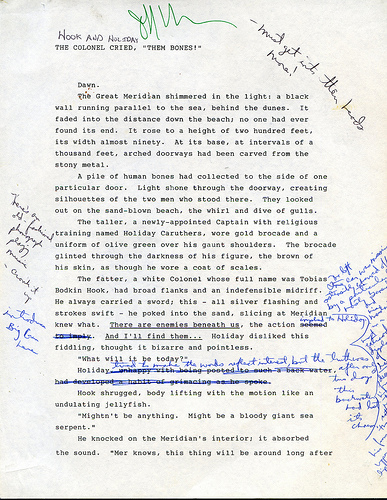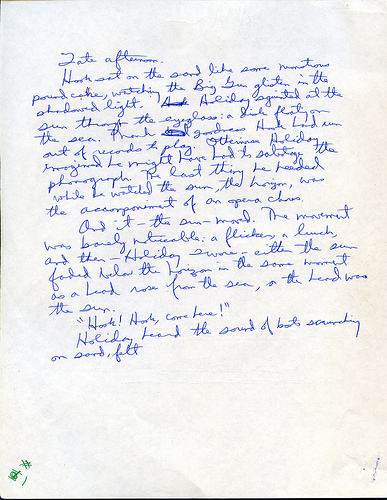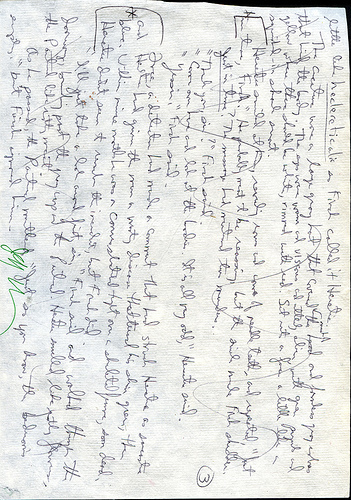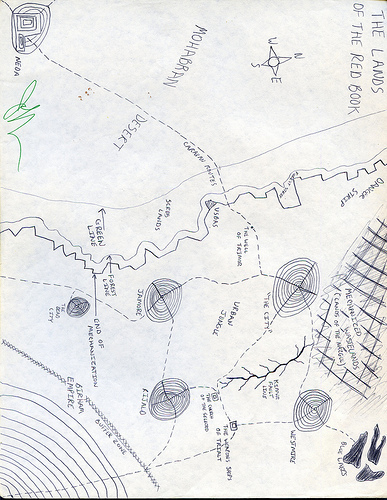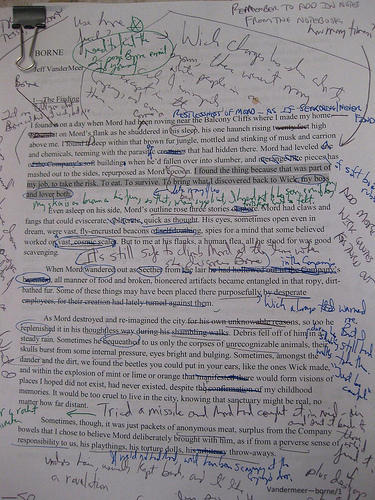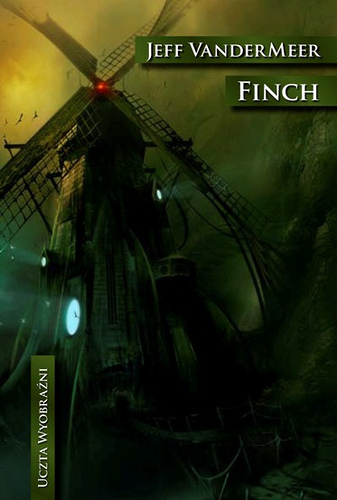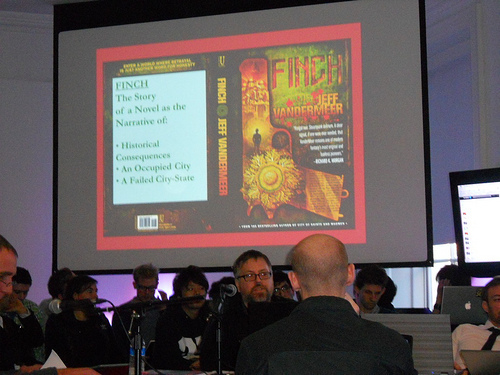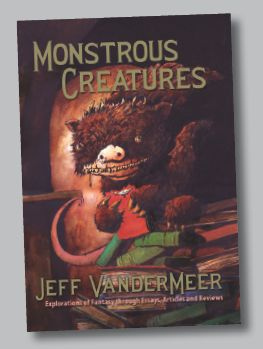Jeff VanderMeer's Blog, page 74
December 8, 2010
Everything You Need to Know to be a Fiction Writer
It's all under the cut…
WORK HARD. PUT IN THE TIME. STOP GRIPING. IGNORE WHAT ANYONE ELSE IS DOING. READ A LOT. USE WHATEVER SCRAP OF TALENT GENETICS AND ENVIRONMENT GAVE YOU. DON'T STIFLE YOUR IMAGINATION. QUIT IF IT'S TOO TOUGH. WHO CARES IF YOU FAIL. THERE ARE PLENTY OF OTHERS OUT THERE.
THERE ARE NO SHORTCUTS.
THAT IS ALL.
Everything You Need to Know to be a Fiction Writer originally appeared on Ecstatic Days on December 8, 2010.




December 7, 2010
Cory Doctorow's With a Little Help

Cory Doctorow's self-publishing experiment, a new short story collection, is now out. It includes contributions for endpapers and the like from a ton of other creators. I contributed a few pages from early unpublished stories, from Finch, and a map for a defunct fantasy land of mine. You can see what I contributed below the cut. Man, that Space Guard juvenalia is some crappy crap crap.
Cory Doctorow's With a Little Help originally appeared on Ecstatic Days on December 7, 2010.
December 6, 2010
Chunakah Interview with Ann VanderMeer
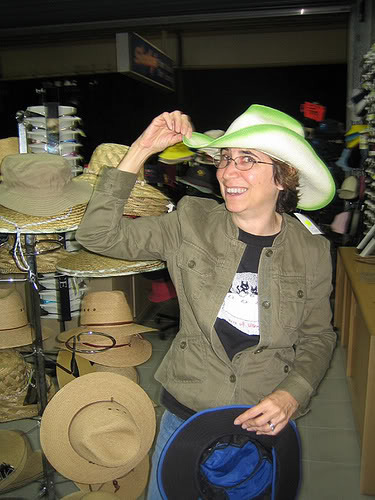
Great interview with Ann here, about Weird Tales, being a female editor, and about Jewish topics.
For example, I started out my software career back in the 1980's. When I would attend software conferences, I would be one of 3 women out of 150 attendees. That's not true today – now it's about 50/50. Do I still have to suffer fools? Of course, but it's a lot better that it was…And yes, there are still idiots out there that will judge you based on your gender/religion/skin color, etc. but for the most part I think that we are all being judged based on our work. Yes, maybe we, as women, have to work harder. I think we are not forgiven for mistakes as easily as our male counterparts are, and we are more scrutinized, but overall we've made so many strides.
They're also giving away a copy of the Kosher Guide to Imaginary Animals (which, btw, as SF Signal noted, without irony, makes a "great stocking stuffer").

Chunakah Interview with Ann VanderMeer originally appeared on Ecstatic Days on December 6, 2010.
Artist Ivica Stevanovic Has a Blog!
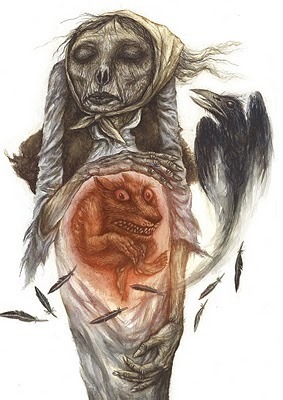
I love Ivica Stevanovic's art. Just love it. And now he has a blog. His first post shines a spotlight on just one project of his, and thus on one of his many approaches to art. This is more traditional than some of his work, but still awesome.
Ivica is working on a graphic novel adaptation of Finch and will be illustrating a future bestiary project of ours, in addition to having art in Steampunk Reloaded and the Thackery T. Lambshead Cabinet of Curiosities.
Artist Ivica Stevanovic Has a Blog! originally appeared on Ecstatic Days on December 6, 2010.
December 3, 2010
Borne in Progress
After helping Ann deliver the Lambshead Cabinet antho, I'm back on track with my novel Borne.
In case anyone thinks writing a novel is a swift or easy thing to do, above find the marked-up first page of Borne above. I think it's safe to post this since I've posted a version of this opening before.
Process-wise, I originally wrote the description of Mord in this post-apoc city with no real sense of the character's point of view. I was more interested in getting down the description/details and making it a tactile, real experience. So I polished that until it was in shape for that initial, very simple purpose.
But, as usually happens, you get a deeper sense of character as you write, and have to go back. Somewhere around 10,000 words, the character clicked into focus and the next 10,000 words were different in style and voice. I let that run out to about a total of 35,000 words before coming back to the beginning, just so I'd have enough text to work with.
Now that I'm going back over the manuscript frag, that first 10,000 will change radically in voice as well as structure, and that will affect the next 25,000 because some stuff that occurs later in the novel will be placed closer to the beginning and the whole thing will eat itself and regenerate along different lines. Among the things that entails is fleshing out a character called the Magician, researching the history of traps, and reading Mike Davis's Dead Cities.
The page above had gone through five drafts to get the description down, and now I'm ripping up the floorboards and constructing a different kind of room, so to speak. Some changes have to do with the narration, some with moving around information, some with setting. And in more than a few places this draft had way too many words better suited for an essay. I was much too in love with the descriptions, which would work perfectly well if this were a short-short. But it's not. It's the opening of a novel that is supporting, foreshadowing, and setting up many different things. In an odd way, it has to be simpler to become more complex. And, since I now know I'm writing a novel not a novella the opening can simultaneously convey less pure information since I have more space to add in what needs to be added in to properly contextualize.
A lot of this may seem bloodless in the way I'm describing process, but it's actually an extremely personal, intimate, and emotional type of drafting, as my aim is to remain true to character and to the integrity of the events that should occur. There are also issues of balancing types of scenes, as the past is integral to the present of the story, but big lumps of past inserted incorrectly will, from the reader's point of view, just slow down the story. So they must be correctly connected to the other scenes, including transitions that aren't arbitrary or surface but hardwired and integral to the narrative.
All in all, just another day on the job, and immensely satisfying. But: requiring patience. Shortcuts and thinking something is done when it isn't are killers to drawing out the full potential of a manuscript.
Borne in Progress originally appeared on Ecstatic Days on December 3, 2010.




December 2, 2010
Finch in Poland: Feb 2011
Finch is out in Poland in February of next year. There's more info here.
Finch in Poland: Feb 2011 originally appeared on Ecstatic Days on December 2, 2010.




Purging the Past: Ambergris Beta Version, Frag #1
[encoded on the back of the dust jacket photo on the original hardcover of City of Saints:] I didn't disappear. I tripped through one of the [redacted]. I became Samuel Tonsure, trying forever to return but failing, while my doppelganger, put in place by Dar Sarduce's people, continued to write about the place: a hollow man writing an echo while I continued to flail through the history of the place, the link between me and my surrogate a hair-thin connection between my waking thoughts and his sleeping dreams. It is not because of the internet that he feels weak and attenuated at times. It is because he exists in two places at once, and is the copy. [airlifted: 3quests/sarnod]
Eventually, I came to a halt. I came to the edge of an underground sea. I became content in my exile and the world I had come from became the dream. I rested there dormant and then dead for a long time.
Then Duncan Shriek came and ate my memories. Brought me back. In his head. An original now a copy. Forever ensconced within his brain and copies of his brain. The link with my doppelganger renewed, faded, then severed for good.
Once, I stood on the shore of an endless sea and wondered what would become of me. Now I am everywhere and nowhere. Now I am at rest.
Purging the Past: Ambergris Beta Version, Frag #1 originally appeared on Ecstatic Days on December 2, 2010.




December 1, 2010
Excerpt: Finch Presentation, Thrilling Wonder Stories 2 Conference
From Thrilling Wonder Stories 2 (Nov. 26, London)
The Occupiers, the gray caps, flood the city. They transform the city of Ambergris through chaos and purpose. And six years later, Finch is stuck within the new order as reluctant collaborator. Is compromised by his mere presence in a police station, his status as investigator of a double murder that the rebels don't want him to solve and his inhuman bosses insist he solve on penalty of his life.
But what does the Rising mean for the city of Ambergris? What does it mean for the spaces Finch must negotiate in his investigation? What is the city occupied, and what is it as a failed state?
As the city moves to a post-colonial situation, it is becoming a colony again, just for a different side. It is becoming contaminated from within and without. An occupied city can be a city in a straitjacket—martial law, curfews, road blocks, imprisonments—but occupied cities that also exist as failed cities can have both less and more agency. They are simultaneously closed vessels and extremely porous. The cross-pollination that occurs creates hybrids of necessity, and allegiances that make little sense out of context.
In Ambergris, then, Occupation takes roughly three forms.
Reconstruction, Renovation, and Transformation. All three of these contexts or states of being impact not just the city's present, but also its past and its future.
—Re/Construction: Rebuilding and new construction that alters the very map of the city in ways that favor the Occupier.
—Renovation: Perhaps more properly, repurposing, as in the repurposing of existing spaces.
—Transformation: More radical than "construction" or "renovation," "transformation" creates change in an irreversible way while at times revealing the gap between the reach and intent of the occupier and the culture of the occupied. These transactions sometimes lead to situations beyond the ken of even the occupier.
It is in all three states that my fantasy world and the real world coincide, echo, and mirror—communicate with each other.
In addition to the flooding of the city, the creation of canals, as an exercise in engineering-as-warfare, the gray caps pursue other projects that constitute construction or reconstruction, changing the nature of spaces within the city.
First, the fungal cathedrals, also known as mushroom houses, which are structures imposed upon the map of the city in even a less organic way than the water released to flood and form walls in the form of canals. These structures either burst up out of the ground overnight, creating dissonance for the inhabitants by rapidly transforming familiar landscape—or spores infiltrate ordinary brick-and-mortar houses and buildings, gradually devouring them, until nothing remains except the fungal "skin", the interiors facsimiles of the original spaces—like but unlike what was there before. This is aggressive colonization by the Occupier and has its clear parallels in our own world.
The two towers being built in the bay, on the other hand, represent an event almost always on the verge of happening—a completing that is never quite complete, causing a suspended and continual sense of dread and speculation: "At dusk each day the gray caps lead a work force from the camps south of the city. All night, the sounds of hammering and construction. Emerald lights moving like slow stars. Screams of injury or punishment. While along the lip of the bay, monstrous fungal cathedrals rise under cover of darkness, skyline a jagged, never-healing wound."
Whereas the purpose of the fungal cathedrals is obvious and immediate, the two towers are a slow-motion, long-term terror campaign waged by the Occupier on the Occupied. The replacement of existing spaces and structures with repurposed spaces and new structures takes place within a certain context. But the two towers require the application of the imagination in frightening ways because it also implicates the citizenry in unknown intent through the use of slave labor. People become conspirators in the creation of their own terror. This is another calling card of the Occupier, whether in our present or an alternate present.
These towers don't exist without the real world, however—something rising to possibly destroy instead of something falling to destroy. This rose out of my subconscious, so that the extrapolation about these towers in the novel is not only my reconstruction of dream but also an attempt to make sense out of senselessness.
To be continued…
Excerpt: Finch Presentation, Thrilling Wonder Stories 2 Conference originally appeared on Ecstatic Days on December 1, 2010.




Monstrous Creatures to Debut at FOG Con, March 2011
Happy to finally have a release date for my nonfiction collection: March 2011. The delays have been my fault entirely, due to the pressure of other deadlines (like delivering, with Ann, 750,000 words of The Weird to Atlantic). You can preorder the hardcover or trade paper here. The publisher's description of the book, cover by Eric Orchard:
Guide Dog Books is proud to announce the release of Jeff VanderMeer's Monstrous Creatures: Explorations of Fantasy through Essays, Articles and Reviews. An entertaining, eclectic chronicle of modern fantastical fiction, this collection delivers incisive commentary, reviews, and essays pertaining to permutations of the monstrous, whether it's other people's monsters, personal monsters, or monstrous thoughts. A two-time winner of the World Fantasy Award, Jeff VanderMeer is one of speculative fiction's foremost voices. For the past 20 years, he has not only written weird literary fiction, translated into 20 languages, but written about it extensively, influencing the way people think about fantasy through reviews in major papers like The Washington Post and The New York Times, as well as through interviews, thoughtful essays, blog posts, teaching, and guest-speaking. Monstrous Creatures, a follow-up to his 2004 nonfiction collection Why Should I Cut Your Throat?, collects all of his major nonfiction from the past five years, including such controversial pieces as "The Romantic Underground," "The Triumph of the Good," and "The Language of Defeat." Interviews with writers like Margo Lanagan and China Miéville are an added bonus, creating a dialogue with VanderMeer's own interpretations of the monstrous in the fantastical.
Monstrous Creatures to Debut at FOG Con, March 2011 originally appeared on Ecstatic Days on December 1, 2010.




November 30, 2010
Just a Regular Guy, Hip to Social Media
No further comment needed, really..
Just a Regular Guy, Hip to Social Media originally appeared on Ecstatic Days on November 30, 2010.





